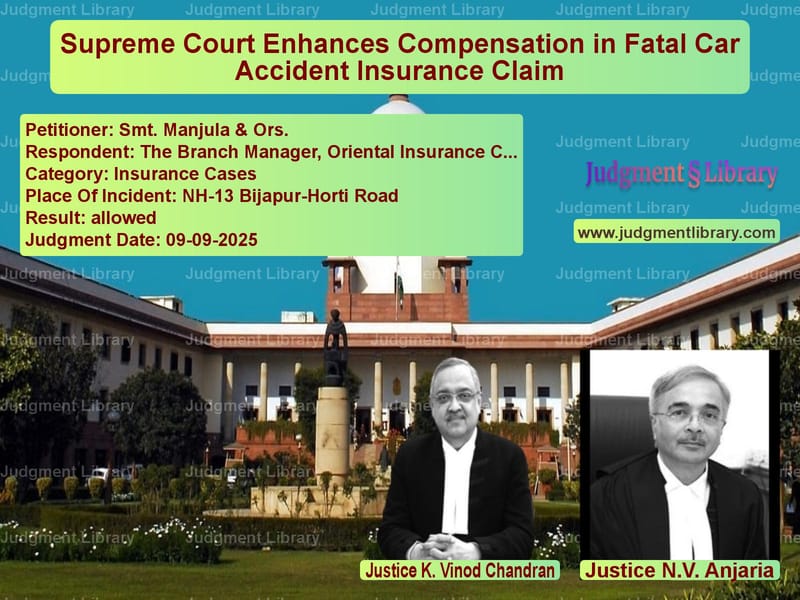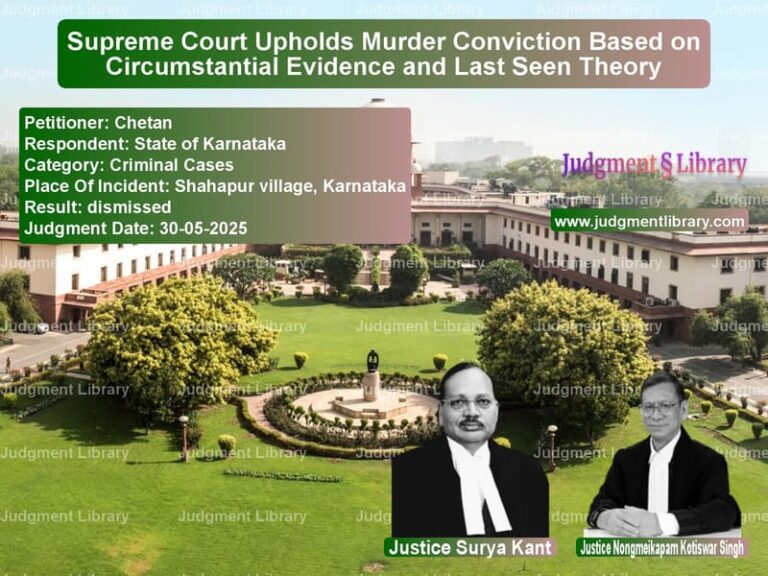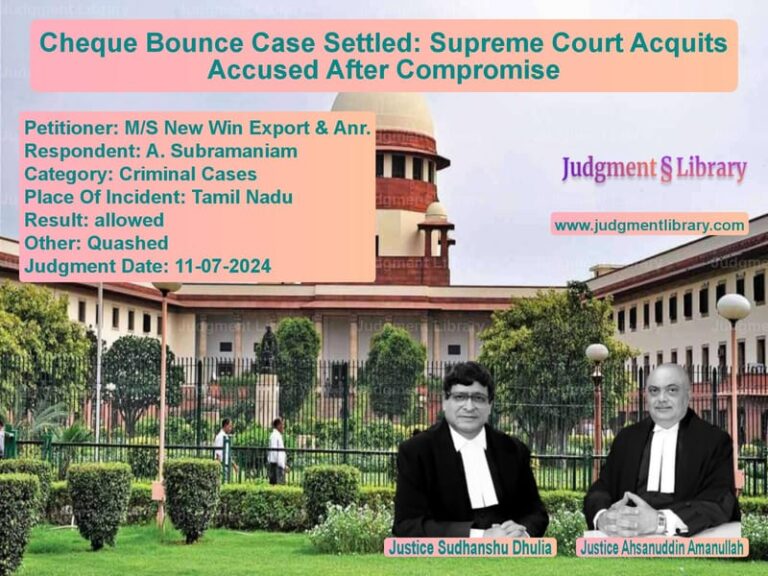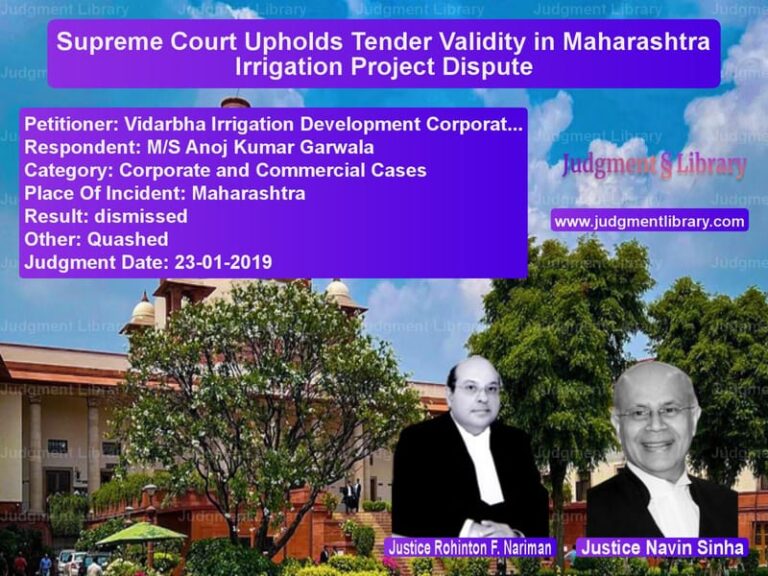Supreme Court Enhances Compensation in Fatal Car Accident Insurance Claim
The tragic loss of life in a road accident is a devastating event for any family, leaving behind not only emotional scars but also significant financial uncertainty. When four friends from Bijapur embarked on a pilgrimage to Shirdi, their journey ended in unimaginable horror. The car they were travelling in was hit head-on by a rashly and negligently driven goods lorry on NH-13 Bijapur-Horti Road. The impact was so severe that all occupants of the car died on the spot. This incident set the stage for a long legal battle fought by the bereaved families, a battle that recently reached its conclusion at the Supreme Court of India. The case, Civil Appeal No. 11425 of 2025, pitted the families of the victims, represented by Smt. Manjula and others, against the Oriental Insurance Company Ltd.
The legal journey began with claim petitions filed before the Motor Accidents Claims Tribunal. The Tribunal awarded compensation, but the families, feeling the amount was insufficient to secure their futures, filed appeals seeking enhancement. The Insurance Company, in turn, filed cross objections. The High Court, in its order, paradoxically reduced the monthly income of one of the deceased without providing any reasoning, even while enhancing the total compensation by adding future prospects. It was this reduction that formed the crux of the appeal before the Supreme Court. The core of the dispute was not about who was at fault—the negligence of the lorry driver was undisputed, and the lorry was validly insured—but about the true value of the life lost and the appropriate compensation owed to the dependents.
The Central Dispute: Determining the Deceased’s Income
The heart of this legal battle revolved around the monthly income of the deceased husband of the first claimant. The Tribunal had initially determined his income to be Rs. 6,000 per month. However, the High Court, in a puzzling move, reduced this figure to Rs. 5,500 per month. The Supreme Court noted a critical flaw in the High Court’s approach. The judgment states, “without any reasoning and without reliance to any material, the High Court reduced it to Rs.5,500/-“. This lack of justification became a pivotal point for the apex court’s intervention.
The appellants, through their learned counsel, vehemently argued for a much higher income. They presented the deceased as a multifaceted individual with several sources of earnings. He was described as the proprietor of a medical shop, a partner in a pharmaceutical distributorship, and a Director of a Cooperative Bank. The appellants claimed his income was as high as Rs. 2,25,000. However, the Insurance Company’s counsel countered these claims, pointing out that these “tall claims were not substantiated” with sufficient evidence.
The Supreme Court meticulously examined the evidence that was on record. It was proven that the deceased held a diploma in Pharmacy. However, his claim of running a medical shop fell through because his licence had been cancelled two years before the accident in 2008. While his involvement in a pharmaceutical distributorship partnership was established, the income from this venture was not proven as the documents were not authenticated and the partners were not examined. Similarly, the claim regarding his Directorship and the receipt of sitting fees was not fully substantiated. It was in this context of partial proof that the Tribunal had originally settled on Rs. 6,000, a figure the High Court reduced without basis.
The Supreme Court’s Reasoning and a New Benchmark
The Supreme Court found the High Court’s reduction of income arbitrary. To arrive at a fair and just figure, the bench, comprising Justices K. Vinod Chandran and N.V. Anjaria, turned to judicial precedent and a pragmatic assessment of the circumstances. The Court recalled its own judgment in Ramachandrappa v. Royal Sundaram Alliance Insurance Co. Ltd., where it was observed that even a “Coolie would be earning an amount of Rs.4,500/- in a month” in the year 2004. Applying an incremental increase of Rs. 500 per year, the Court reasoned that by 2010, the year of the accident, a labourer would have earned around Rs. 7,500 per month.
The Court then considered the profile of the deceased. He was not an unskilled labourer but a qualified Diploma holder in Pharmacy, involved in business ventures and associated with a Cooperative Bank. Even though the exact income was not proven, his qualifications and activities indicated a higher earning capacity than a manual labourer. The Court stated, “Considering the overall circumstances, it can be safely assumed that the deceased would have obtained a monthly remuneration of Rs.12,000/- to look after the family of five comprising of himself, his wife, minor daughter and two parents.” This assumption formed the new foundation for calculating compensation.
Recalculating the Compensation
With the monthly income set at Rs. 12,000, the Supreme Court proceeded to recalculate the compensation in accordance with the established principles laid down in the Constitution Bench judgment of National Insurance Co. Ltd. v. Pranay Sethi. The Court affirmed the multiplier of 14, which was appropriate given the deceased was 43 years old. It also upheld the addition of 25% of the established income towards “future prospects”, as the deceased was self-employed.
Since the deceased had four dependents—his wife, minor daughter, and two parents—the Court correctly applied a deduction of one-fourth (1/4th) towards his personal and living expenses. The calculation for loss of dependency was thus: Rs. 12,000 (monthly income) x 12 (months) x 3/4 (after deduction) x 14 (multiplier) x 125% (including future prospects) = Rs. 18,90,000.
Furthermore, the Court awarded conventional heads as mandated by law. For funeral expenses and loss of estate, Rs. 15,000 each was granted. Crucially, on the head of loss of consortium, the Court followed the precedent in New India Assurance Company v. Somwati and Ors., which recognizes that not only the spouse but also children and parents are entitled to consortium. Therefore, it awarded Rs. 40,000 each to the wife, the minor daughter, and the two parents, totaling Rs. 1,60,000.
The Final Award and Directions
The Supreme Court consolidated the amounts into a final award. The total compensation was calculated as follows: Loss of income at Rs. 18,90,000, plus funeral expenses at Rs. 15,000, plus loss of estate at Rs. 15,000, plus loss of consortium at Rs. 1,60,000. This brought the grand total to Rs. 20,80,000.
The Court directed that this enhanced amount be paid to the appellants by the Insurance Company within three months. The amount already paid was to be deducted, and the balance was to carry interest at the rate of 6% per annum from the date of the original application before the Tribunal. The apportionment of the compensation, as decided by the Tribunal, was to remain unchanged. With these directives, the Supreme Court “allowed” the appeal, bringing a measure of financial justice to the grieving family after a protracted legal struggle.
This judgment underscores the judiciary’s role in ensuring that compensation in motor accident claims is not merely symbolic but realistic and sufficient to support the families left behind. By setting aside an arbitrary reduction of income and using a principled, precedent-based approach to determine a fair income, the Supreme Court has reinforced the compassionate purpose of the law of torts and motor vehicle legislation. It serves as a vital reminder that the value of a human life must be assessed with sensitivity and a clear-eyed view of economic realities.
Petitioner Name: Smt. Manjula & Ors..Respondent Name: The Branch Manager, Oriental Insurance Company Ltd. Bijapur & Anr..Judgment By: Justice K. Vinod Chandran, Justice N.V. Anjaria.Place Of Incident: NH-13 Bijapur-Horti Road.Judgment Date: 09-09-2025.Result: allowed.
Don’t miss out on the full details! Download the complete judgment in PDF format below and gain valuable insights instantly!
Download Judgment: smt.-manjula-&-ors.-vs-the-branch-manager,-supreme-court-of-india-judgment-dated-09-09-2025.pdf
Directly Download Judgment: Directly download this Judgment
See all petitions in Motor Insurance Settlements
See all petitions in Compensation Disputes
See all petitions in Road Accident Cases
See all petitions in Third-Party Insurance
See all petitions in Insurance Settlements
See all petitions in Judgment by K. Vinod Chandran
See all petitions in Judgment by N.V. Anjaria
See all petitions in allowed
See all petitions in supreme court of India judgments September 2025
See all petitions in 2025 judgments
See all posts in Insurance Cases Category
See all allowed petitions in Insurance Cases Category
See all Dismissed petitions in Insurance Cases Category
See all partially allowed petitions in Insurance Cases Category







